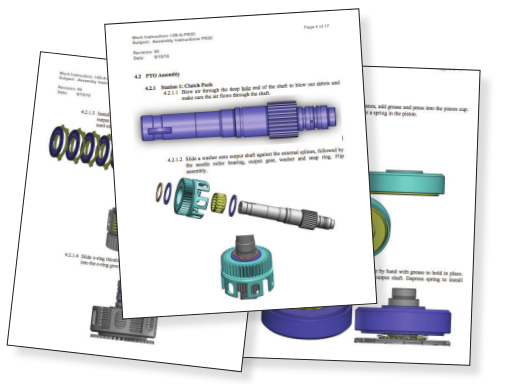A Picture's Worth a Thousand Words
Featured in Muncie Power Quarterly, Issue 3, 2017
Work instructions at Muncie Power Products were once simply text. But today, new work instructions are being created with visuals. Thanks in large part to Senior Industrial Engineer Melissa Rucker, these visual work instructions have made power take-off assemblies more efficient.
“My goal is to have anyone be able to put a PTO together,” said Melissa.
According to Melissa, many people learn by tactile and so, for this reason, visual work instructions are the closest that can be provided to tangible instructions.
“You can’t argue with a picture, but you can have different interpretations with wording,” she said. “With a picture, there’s no question what’s the top of a clutch hub.”
PROCESS TO CREATE
When creating these instructions, Melissa has to ensure the right orientation is captured and the suggested build order included. But to really understand this, the creator has to know the product and its assembly first.
 To do this, Melissa suggests first building the product as she has done to gain the right perspective. Moving forward, she then uses the solid models created by the design engineers in SOLIDWORKS® to create these instructions.
To do this, Melissa suggests first building the product as she has done to gain the right perspective. Moving forward, she then uses the solid models created by the design engineers in SOLIDWORKS® to create these instructions.
“Design engineers design the assembly and then what I do is color code,” explained Rucker. “I color code every piece for that particular step.”
As Melissa described, the first step is color coded blue, then yellow – second, then bright teal and so forth in contrasting colors until the assembly is complete; in which case, all items will be grayed out. Regardless of the assembly, the steps will be the same, consistent colors.
Getting input from and verifying with those who assemble these products throughout this color-coding process is critical to capturing the most beneficial and efficient build order.
VALUE
While visual work instructions create consistency, they also help ensure quality, promote efficiency and serve as a great reminder on products assembled less often.
“We just want to optimize time and the number of touches,” she said.
Visual work instructions allow the assembler to see what the first piece is and so forth along with how all the pieces fit together. And by working with assemblers, the visual work instructions reflect the most efficient build order – reducing time spent and the number of touches to help ensure quality.
“Doesn’t prevent it [mistakes], but more likely to see oh this highlighted blue is the first piece,” Rucker said. “I’m also not doing it in a vacuum, I involve the assemblers working on it.”
CHALLENGES
Creating visual work instructions can be time consuming as the color must be changed for every part, constructing exploded views of the assembly – while preferred – is time intensive and parts must be turned off and on throughout the process to show each step in the assembly. Configurations can also be infinite, which can make selecting one to cover all the basics difficult.
All in all, visual work instructions are just another way in which the company is carrying out its efforts of continuous improvement of lean, taking something already in use and making it better—according to Melissa.
“People don’t know what industrial engineers do, but I’m really part of making a better process,” she said.


